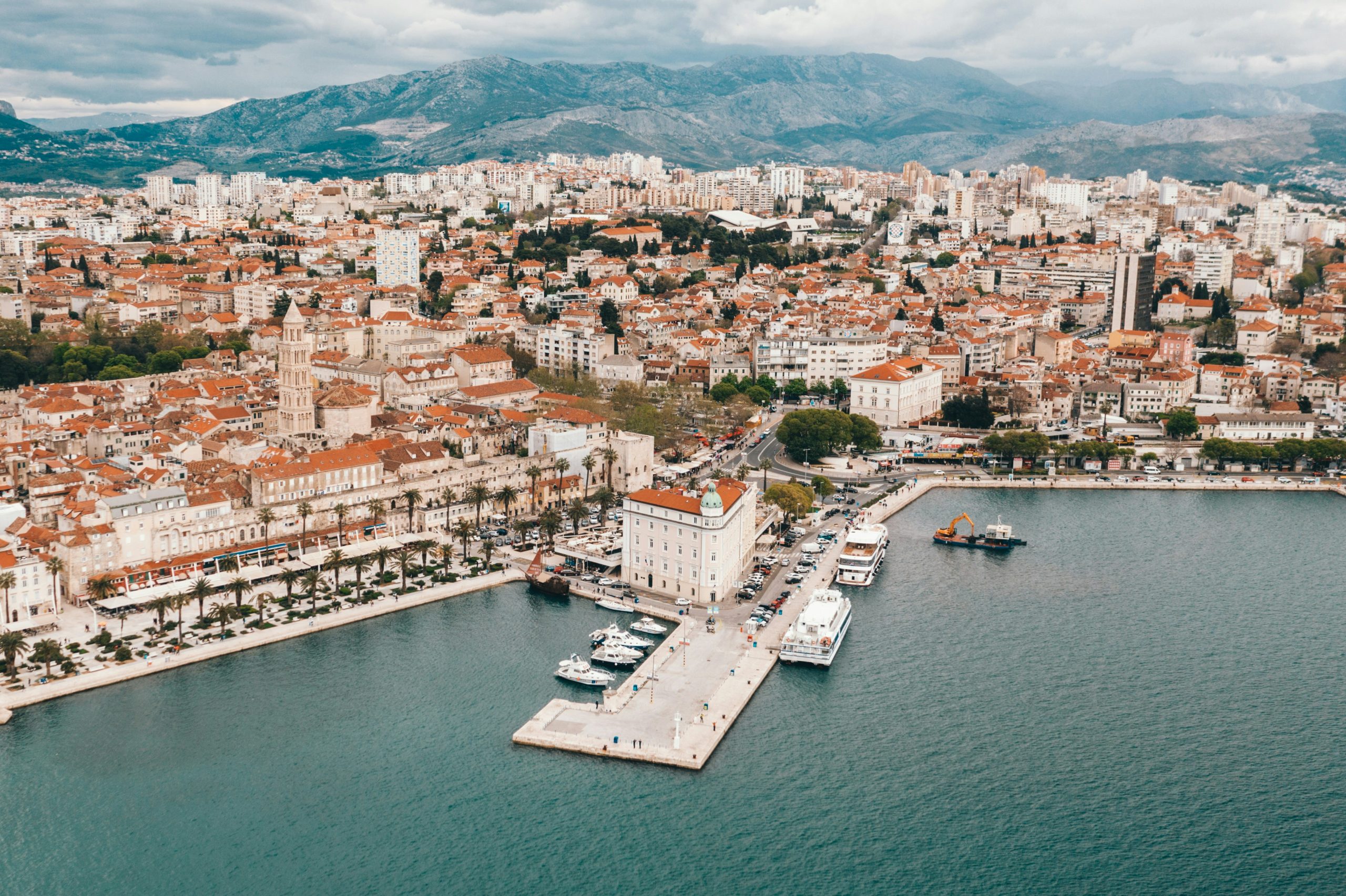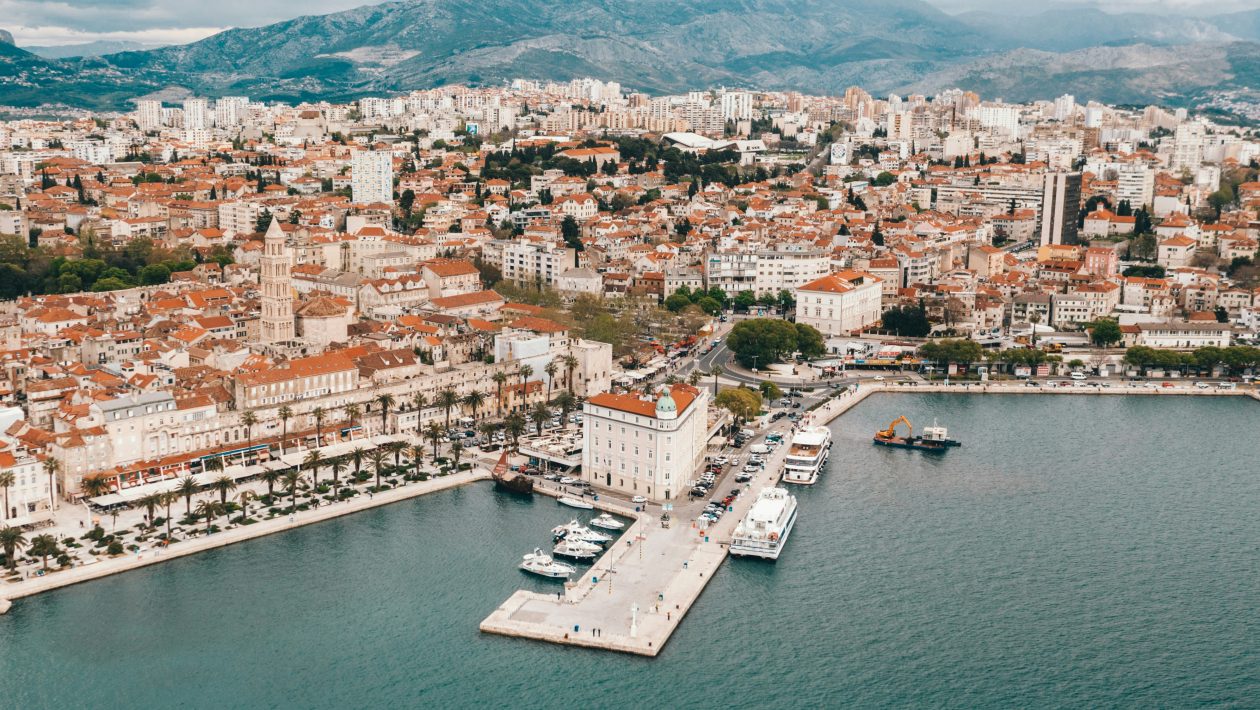It will take you only 20 minutes to get to Split from the Hostel Adria. Split is a vibrant city located on the Dalmatian Coast, offering a rich blend of historical, cultural, and natural attractions.

Known for its stunning coastline, bustling markets, and a plethora of ancient sites, Split is a destination that captivates every visitor. Whether you are a history enthusiast, an art lover, or someone looking for a relaxing day in nature, Split has something to offer for everyone. Below is a guide to some of the must-see attractions in Split, complete with addresses and Google Maps links for your convenience.
Palace of Diocletian
The Palace was built in the typical Roman military camp style by the architects Filotas and Zotikos. Emperor Diocletian lived in the Palace for only eight years until he died in 313 A.D. After his death, the Palace was used as an administrative center and the governor’s residence. In 615, the Palace of Diocletian served as a refuge for the residents of Salona from the Avar invasion.
The Palace of Diocletian is a well-preserved building, featuring notable attractions such as the Temple of Jupiter, Cathedral of St. Domnius, and the Peristyle. As a UNESCO World Heritage Site, it is one of the standout attractions in Croatia.
- Trg Peristil 1, 21000 Split, Croatia
- Auf Google Maps ansehen
The Baptistery of St. John (former Jupiter Temple in the Palace of Diocletian)
Originally a Roman religious building, the Temple of Jupiter was consecrated in the 6th century. After its consecration, it became known as the Baptistery of St. John (Sv Ivan Krstitelj). Notable features in the Baptistery include the baptismal font with a panel representing King Zvonimir, as well as other remarkable elements.
Two bishops were entombed in the Baptistery of St. John: Bishop John from the 8th century and Bishop Lawrence from the 11th century.
- Kraj Sv. Ivana 3, 21000 Split, Croatia
- Auf Google Maps ansehen
Brace Radica Square (a square on the territory of Diocletian Palace)
Brace Radica Square is a medieval square located in the southwest of the Diocletian Palace in Split.
A statue of Marko Marulic, considered the founder of Croatian literature, is one of the main attractions for tourists on Brace Radica Square.
Another point of interest is the Marina Tower (Hrvojeva Kula), built in the 15th century, it is the only remaining part of a Venetian castle at Brace Radica Square.
On the northern section of the square, the Baroque-style Milesi Palace, dating from the 17th century, is located.
- Brace Radica 5, 21000 Split, Croatia
Cathedral of St. Domnius (located on the territory of Diocletian Palace)
Originally Diocletian’s mausoleum, the Cathedral of St. Domnius (Katedrala Sv. Duje) was designed by Filotas and consecrated in the 7th century. The appearance of the Cathedral has remained practically unchanged until today. The only addition is a 60m/197ft bell tower built between the 12th and 16th centuries. From the bell tower, you can enjoy a panoramic view of the Palace of Diocletian.
Noteworthy features within the Cathedral include the Altar of St. Domnius and the 13th-century hexagonal Romanesque stone pulpit.
- Kraj Sv. Duje 5, 21000 Split, Croatia
Museum of Split (located within the Palace of Diocletian)
The Museum of Split occupies the former Gothic Papalic Palace that is considered to be the finest of the 15th and 16th-century buildings constructed in the Palace of Diocletian’s open areas. The Gothic Papalic Palace was built by the master Juraj of Dalmatia.
The museum was founded in 1946 and is noted for its collection of books illustrating the history of Split from the 12th to 18th centuries.
- Papalićeva 1, 21000 Split, Croatia
Split Archaeological Museum
One of the oldest museums in Croatia, the Archaeological Museum of Split is a must-see for a tourist. The Museum was founded in 1820. Later it changed its location. In 1922, the Museum found its present location.
Approximately 150,000 items are kept in Split, including the largest Croatian collection of gems. Among other collections, there are Roman glass, stone carvings from Salona, Greco-Hellenistic ceramics, about 1600 ancient clay lamps, and many other bone and metal objects.
- Zrinsko-Frankopanska 25, 21000 Split, Croatia
Marjan Forest Park
After a long walk around the bustling city of Split, tired tourists find shelter under the pine trees of Marjan Forest Park. From the vantage point of Telegrin, you can enjoy spectacular views of the sea.
It takes only about a 15-minute walk to reach Marjan Forest Park from central Split. The way goes through the old quarter of Varos.
- Marjan, 21000 Split, Croatia
Mestrovic Gallery
One of the most outstanding sculptors of the 20th century, a friend of the renowned Rodin, Ivan Mestrovic lived in this building in the 1930s. Later, in 1950, his house was transformed into the Mestrovic Gallery after Mestrovic had made a substantial donation of his art that is the bulk of the Gallery. Here you can see the most famous sculptures of Mestrovic. The gallery contains 17 drawings, eight bronze statues in the open garden, 28 reliefs in wood, and a stone crucifix.
- Šetalište Ivana Meštrovića 46, 21000 Split, Croatia
Museum of Croatian Archaeological Monuments
An indispensable part of a tourist visit to Split should be, of course, the Museum of Croatian Archaeological Monuments – one of the oldest Croatian museums. It is still actively collecting and researching new items, mostly in South Croatia. In a building designed by M. Kauzlaric and built in 1976, the collection of 20,000 items is kept. About a quarter of the collection, including stone carvings from Croatian churches, jewelry, everyday items, and weapons, is displayed to visitors.
The museum also hosts multiple exhibitions of different characters.
- Šetalište Ivana Meštrovića 18, 21000 Split, Croatia
People’s Square
The People’s Square (Narodni Trg Pjaca) dates from the 15th century. Many buildings in Gothic, Renaissance, and Venetian styles were built here by the local nobility. The most outstanding is the Venetian-Gothic Cambi Palace.
- Narodni trg, 21000 Split, Croatia
The Church of St. Dominic
The Church of St. Dominic was built in the Middle Ages. In the 1930s it was expanded. Its interior is decorated with artwork by Palma il Giovane and his followers: the works titled Miracle in Surian and Apparition in the Temple.
From the marketplace located in the very vicinity, the best view of the Palace of Diocletian is available.
- Hrvojeva 2, 21000 Split, Croatia

